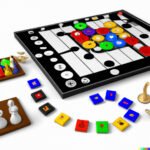Are you a fan of classic arcade game boards? These timeless pieces of gaming history have captured the hearts of players for decades. From Pong to Pac-Man, these games have become iconic symbols of nostalgia and entertainment.
In this article, we will explore the history, technology, and popularity of classic arcade game boards. Whether you’re a collector, enthusiast, or simply curious about the world of vintage gaming, join us as we dive into the fascinating world of classic arcade game boards.
The allure of classic arcade game boards lies in their simplicity, yet undeniable fun factor. Before modern consoles and high-definition graphics, these games were at the forefront of interactive entertainment. From early pinball machines to joystick-controlled classics, these games paved the way for the gaming industry we know today. Join us as we take a trip down memory lane and revisit the games that started it all.
In addition to exploring the history and popularity of classic arcade game boards, this article will also delve into collecting and restoring these vintage treasures. From tips for enthusiasts to preserving gaming history through restoration efforts, there’s much to learn about keeping these timeless games alive for future generations to enjoy. So get ready to embark on a journey through time as we uncover the nostalgia and enduring appeal of classic arcade game boards.
History of Classic Arcade Game Boards
The history of classic arcade game boards is a fascinating journey through the evolution of a form of entertainment that has captivated generations. It all began with the groundbreaking game Pong, created by Atari in 1972.
This simple yet addictive game laid the foundation for the entire arcade industry, and its success paved the way for more advanced games like Pac-Man, released by Namco in 1980. These early classics set the stage for the golden age of arcade gaming in the 1980s, when games like Space Invaders, Donkey Kong, and Galaga became household names.
One of the most significant developments in the history of classic arcade game boards was the introduction of microprocessors. Before this technological advancement, arcade games were built using discrete logic circuits.
The arrival of microprocessors allowed for more complex and visually impressive games to be developed, leading to a surge in popularity for arcade gaming. This shift also made it easier for game developers to create new titles and customize existing ones, resulting in an explosion of creativity and innovation within the industry.
As classic arcade game boards continued to evolve, new features such as color graphics, sound effects, and innovative control schemes were incorporated into games. These advancements not only enhanced gameplay experiences but also contributed to the timeless appeal of classic arcade games. The combination of engaging gameplay and cutting-edge technology solidified their status as beloved cultural icons that continue to resonate with audiences today.
| Classic Arcade Game | Year Released |
|---|---|
| Pong | 1972 |
| Pac-Man | 1980 |
| Space Invaders | 1978 |
Evolution of the Classic Arcade Game Board Technology
The evolution of classic arcade game board technology has been a significant factor in the timeline of gaming history. From the simple circuits of Pong to the more advanced hardware of Pac-Man, classic arcade game boards have come a long way in terms of technology and innovation.
Early Innovations
In the early days of arcade gaming, the technology behind game boards was relatively basic. Games like Pong and Space Invaders relied on simple electronic components such as transistors and diodes. These early game boards were limited in terms of their capabilities, often only able to produce simple black-and-white graphics and sound effects.
Advancements in Graphics and Sound
As technology progressed, so did the capabilities of classic arcade game boards. The introduction of color graphics and digital sound effects revolutionized the gaming experience. Games like Galaga and Donkey Kong showcased the potential for more immersive gameplay through improved visuals and audio. This advancement in technology played a key role in attracting a wider audience to arcade gaming.
Integration of Microprocessors
One of the most significant advancements in classic arcade game board technology came with the integration of microprocessors. Games like Pac-Man utilized this new technology to create more complex gameplay mechanics and AI-controlled characters. This marked a turning point in arcade gaming, allowing for more diverse and challenging games to be developed.
Overall, the evolution of classic arcade game board technology has greatly influenced the gaming industry as a whole, paving the way for modern gaming systems and experiences.
Popular Classic Arcade Game Boards
The classic arcade game boards have brought joy to many people over the years, with iconic games that have become ingrained in popular culture. These games have stood the test of time and continue to be enjoyed by enthusiasts and casual gamers alike. Let’s take a look at some of the most iconic classic arcade game boards that have left a lasting impact on the gaming industry.
Some of the most popular classic arcade game boards include:
1. Pac-Man: Released in 1980, Pac-Man quickly became a cultural phenomenon and is still widely recognized today. The simple yet addicting gameplay made it a hit among players of all ages.
2. Donkey Kong: This 1981 release introduced the world to both Donkey Kong and Mario, who would go on to become gaming icons in their own right. The innovative level design and challenging gameplay made Donkey Kong a standout title.
3. Space Invaders: This 1978 release is often credited with popularizing the shooter genre and demonstrating the potential of video games as a form of entertainment.
These classic arcade game boards paved the way for modern gaming and continue to hold a special place in the hearts of many retro gaming enthusiasts.
Whether you grew up playing these games or are just discovering them now, it’s clear that their impact on gaming history is undeniable. From their innovative gameplay mechanics to their memorable characters, these classic arcade game boards have left an enduring legacy that continues to influence gaming culture today.
Collecting Classic Arcade Game Boards
For enthusiasts and collectors of classic arcade game boards, finding, preserving, and maintaining these iconic pieces of gaming history can be a passion and a labor of love. Whether you are new to collecting or have been an enthusiast for years, here are some tips to help you in your pursuit of classic arcade game boards:
1. Research extensively before making any purchases: Before diving into the world of classic arcade game board collecting, it’s important to research the market, understand the value of different game boards, and familiarize yourself with reputable sellers and sources. This will help you make informed decisions and avoid potential scams or overpriced items.
2. Network with other collectors: Joining online forums, social media groups, or local collector meetups can be invaluable for connecting with other enthusiasts. Networking with experienced collectors can provide insight into where to find rare game boards, how to troubleshoot common issues, and even opportunities for trades or sales.
3. Learn basic repair and maintenance skills: Part of being a classic arcade game board collector involves the ability to perform basic repairs and maintenance on the boards you acquire. Learning how to solder, troubleshoot wiring issues, clean corrosion from components, among other skills will not only save you money but also ensure that your collection remains in working condition for years to come.
By following these tips and being diligent in your pursuit of classic arcade game boards, you can build a valuable collection that not only serves as a reminder of gaming’s golden age but also contributes to preserving this important part of entertainment history.
Restoring Classic Arcade Game Boards
Restoration often involves repairing or replacing damaged components, such as monitors, control panels, and wiring. Many collectors and hobbyists take great care in sourcing original parts to ensure that the game stays true to its original form. The process can be time-consuming and requires a good deal of technical knowledge, making it a challenging but rewarding endeavor.
One popular aspect of restoring classic arcade game boards is the art of cabinet restoration. The cabinets often feature vibrant artwork that has faded over time, requiring careful restoration to bring back their original luster. This attention to detail ensures that these games are not only fully functional but also visually appealing, allowing them to be appreciated by new generations of gamers.
| Classic Arcade Game Board | Restoration Time |
|---|---|
| Pac-Man | 12 hours |
| Donkey Kong | 20 hours |
| Galaga | 15 hours |
Classic Arcade Game Board Maintenance
The Importance of Regular Maintenance
Classic arcade game boards require regular maintenance to prevent issues such as screen burn-in, faulty controls, and electrical problems. Without proper upkeep, these games can deteriorate over time, resulting in decreased performance and eventually rendering them unplayable. By implementing routine maintenance practices, enthusiasts can prolong the lifespan of their classic arcade game boards and continue to enjoy them for years to come.
Tips for Maintaining Classic Arcade Game Boards
Regular cleaning and dusting are essential for preventing dirt and debris from affecting the internal components of classic arcade game boards. Additionally, inspecting the wiring, power supply, and control mechanisms for any signs of wear or corrosion can help identify potential issues before they escalate. It’s also important to store classic arcade game boards in a controlled environment with stable temperature and humidity levels to avoid damage from environmental factors.
Seeking Professional Assistance
For enthusiasts who may not have the technical expertise to perform in-depth maintenance on their own, seeking professional assistance from experienced technicians or restorers can be beneficial. These professionals can diagnose and address more complex issues with classic arcade game boards, ensuring that they remain fully functional and authentic. While it may involve additional cost, entrusting the maintenance of these valuable gaming artifacts to skilled professionals can preserve their historical significance.
The Future of Classic Arcade Game Boards
In conclusion, the future of classic arcade game boards looks bright as the nostalgia for these iconic games continues to thrive. With the popularity of retro gaming on the rise, there is a renewed interest in preserving and collecting classic arcade game boards. Enthusiasts are finding innovative ways to keep these games alive, from restoring old machines to creating new ways to play these vintage games.
One exciting trend in the future of classic arcade game boards is the use of modern technology to preserve and emulate these games. With advancements in hardware and software, it has become easier for collectors and enthusiasts to experience classic arcade games without the need for original game boards. This not only makes these games more accessible but also ensures that they will be enjoyed by future generations.
As we move forward, it is important to continue celebrating and honoring the legacy of classic arcade game boards. These games hold a special place in gaming history and have left an indelible mark on popular culture. By preserving and maintaining these iconic games, we can ensure that the nostalgia for classic arcade game boards will continue to thrive for years to come.
Frequently Asked Questions
What Are the Old Arcade Machines Called?
The old arcade machines are commonly referred to as arcade cabinets. These large, standalone devices housed various video games and were a popular form of entertainment in arcades during the 1970s and 1980s.
What Arcade Game Was 80s Style?
The most iconic 80s-style arcade game was undoubtedly Pac-Man. Released in 1980, this maze-chase game featuring a yellow, circular character became a cultural phenomenon and remains one of the most recognizable video games of all time.
What Is the Most Common Arcade Cabinet?
The most common type of arcade cabinet is the upright arcade machine. These stand-alone cabinets typically featured a vertical screen and controls for one or two players to enjoy classic games such as Space Invaders, Galaga, and Street Fighter. They were a staple in arcades during the 1980s and early 1990s.

I love playing all kinds of games – from classics like Monopoly to modern favourites like Ticket to Ride.
I created this blog as a way to share my love of board games with others, and provide information on the latest releases and news in the industry.





